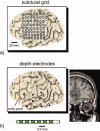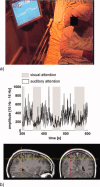Task-related gamma-band dynamics from an intracerebral perspective: review and implications for surface EEG and MEG
- PMID: 19343801
- PMCID: PMC6870589
- DOI: 10.1002/hbm.20750
Task-related gamma-band dynamics from an intracerebral perspective: review and implications for surface EEG and MEG
Abstract
Although non-invasive techniques provide functional activation maps at ever-growing spatio-temporal precision, invasive recordings offer a unique opportunity for direct investigations of the fine-scale properties of neural mechanisms in focal neuronal populations. In this review we provide an overview of the field of intracranial Electroencephalography (iEEG) and discuss its strengths and limitations and its relationship to non-invasive brain mapping techniques. We discuss the characteristics of invasive data acquired from implanted epilepsy patients using stereotactic-electroencephalography (SEEG) and electrocorticography (ECoG) and the use of spectral analysis to reveal task-related modulations in multiple frequency components. Increasing evidence suggests that gamma-band activity (>40 Hz) might be a particularly efficient index for functional mapping. Moreover, the detection of high gamma activity may play a crucial role in bridging the gap between electrophysiology and functional imaging studies as well as in linking animal and human data. The present review also describes recent advances in real-time invasive detection of oscillatory modulations (including gamma activity) in humans. Furthermore, the implications of intracerebral findings on future non-invasive studies are discussed.
(c) 2009 Wiley-Liss, Inc.
Figures





References
-
- Allison T,Puce A,Spencer DD,McCarthy G ( 1999): Electrophysiological studies of human face perception. I. Potentials generated in occipitotemporal cortex by face and non‐face stimuli. Cereb Cortex 9: 415–430. - PubMed
-
- Aoki F,Fetz EE,Shupe L,Lettich E,Ojemann GA ( 1999): Increased gamma‐range activity in human sensorimotor cortex during performance of visuomotor tasks. Clin Neurophysiol 110: 524–537. - PubMed
-
- Axmacher N,Elger CE,Fell J ( 2008a): Ripples in the medial temporal lobe are relevant for human memory consolidation. Brain 131: 1806–1817. - PubMed
Publication types
MeSH terms
LinkOut - more resources
Full Text Sources
Medical
Miscellaneous

